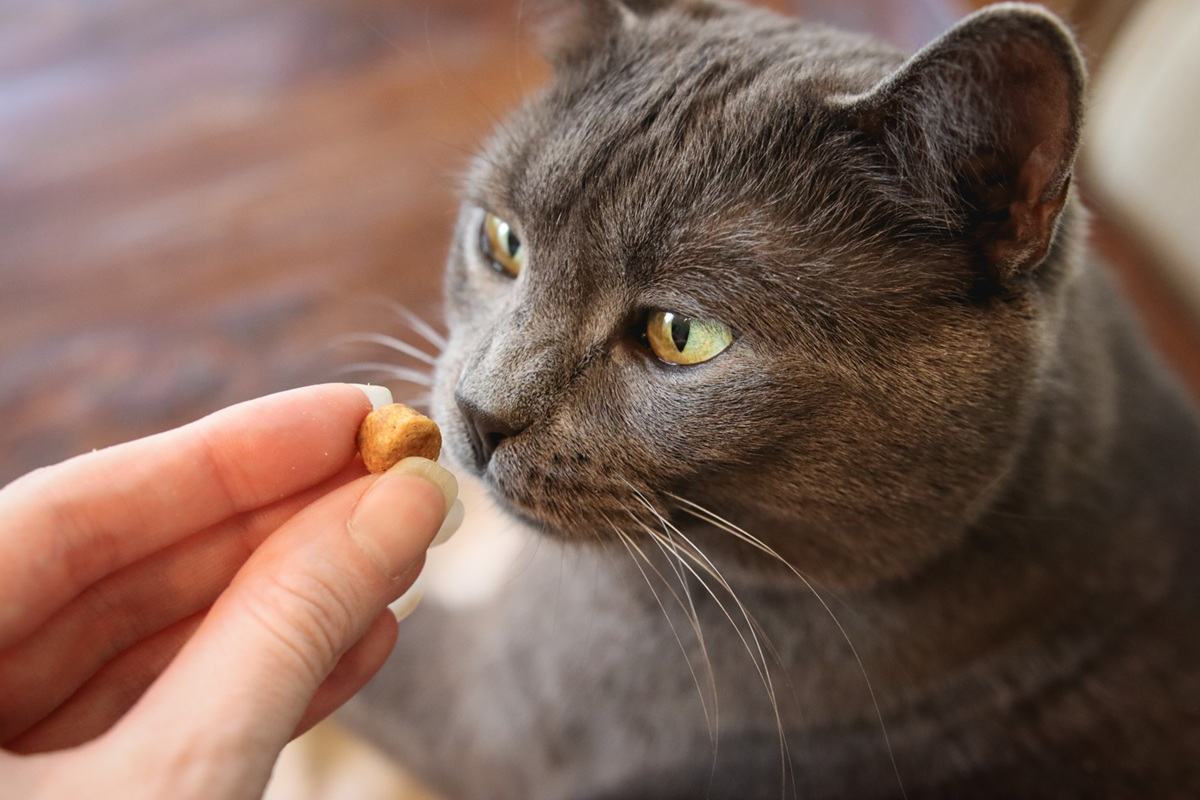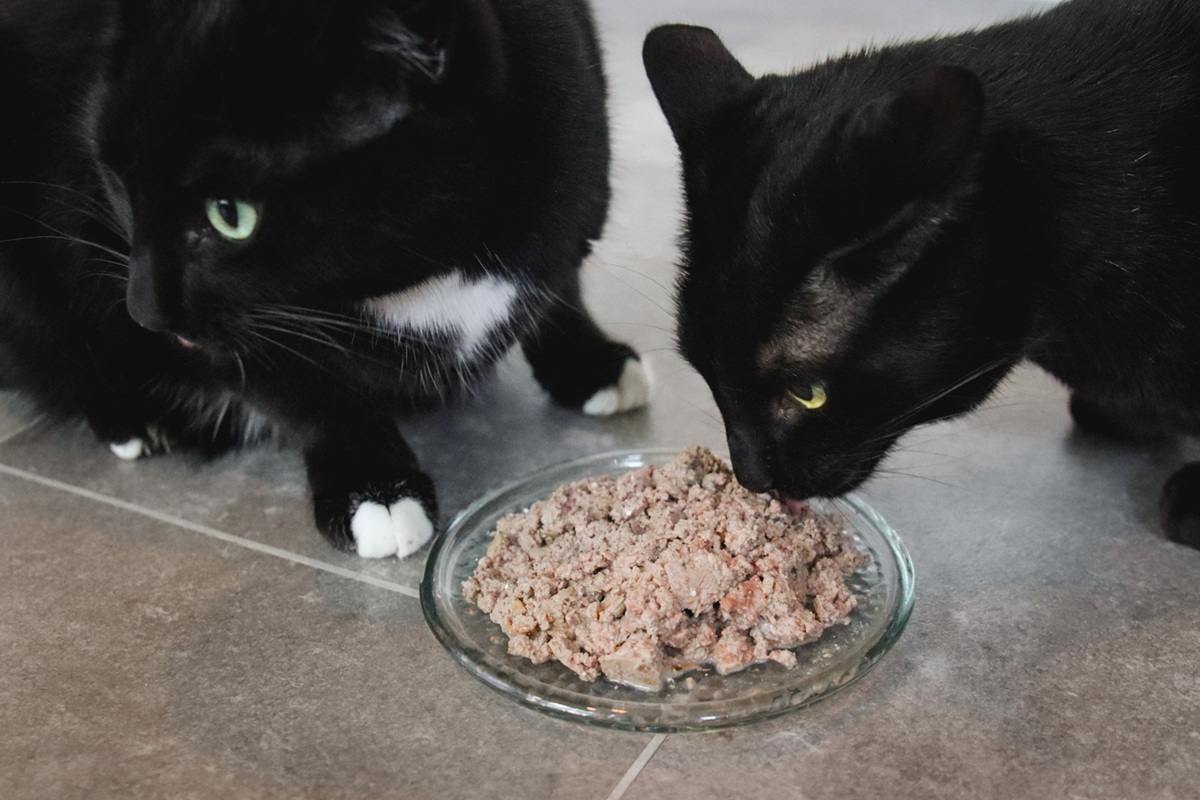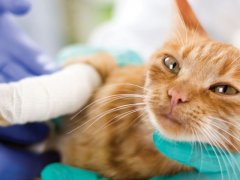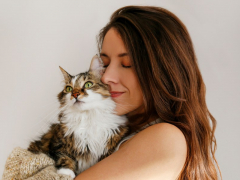
Kirsten McCarthy / Cats.com
Food is a vital resource and a survival mechanism for all species, but what happens when your delightful cat becomes a tiger at mealtimes?
Food aggression is common in dogs with minimal occurrences reported in cats. Food aggression in cats manifests as resource guarding and is subtle in most situations, with serious contributions to obesity, heart disease, and other chronic problems.
In this article, we explore reasons for food obsession, investigate psychogenic abnormal feeding behaviour, and offer practical solutions for better health and welfare of cats and owners.
How Do I Know if My Cat Is Food-Obsessed?

Cats who behave aggressively prior and throughout feeding time might not just be hungry; they could be exhibiting signs of food obsession.
Symptoms include:
- Bowl guarding.
- Growl, swats, or hisses during mealtime.
- Terrorizes other household pets away from their food.
- Steals food, eats through packaging and rubbish.
- Strikes when food is present.
- Spends most of the time in the kitchen, vocalising excessively, begging for food.
Causes of Food Aggression in Cats
Cats are obligate carnivores; their natural diet consists of mostly small rodents with a high requirement for dietary protein so they cannot survive on fruits or plants. The cat’s inability to endure on a vegetarian or vegan diet increases the risk of starvation when prey and food is scarce living outdoors.
Felines, as strict meat-eaters, have extra stringent nutritional requirements and yet seem less adapted than dogs to sense nutritional imbalances so their diet should be complete, balanced, digestible, palatable, and nutritionally safe (without deficiencies).
Cats as solitary predators prefer to eat alone and frequently, inappropriately they are often fed with other cats in proximity. The inability of a cat to access a food resource safely and privately is believed to lead to overeating, obesity, under-eating, and possibly vomiting due to food gorging.
Kittens or cats who experience early weaning, nutrition deprivation or abandonment are predisposed to food preoccupation since food confiscation is perceived as a threat whereas indoor cats relying on humans for food provision are disposed to resource competition due to conflict and pre-feeding aggression when given large volumes of food once or twice daily.
What Is “Psychogenic Abnormal Feeding Behavior” ?
According to research published in the Journal of Veterinary Behavior, some cats are truly consumed with food and will act aggressively toward people and other pets while seeking out and protecting food. Researchers have characterized this unusual conduct as “psychogenic abnormal feeding behaviour.”
The first cat diagnosed with “psychogenic abnormal feeding behaviour” was Otto, an 8-month-old Siamese who was using aggression to get food. Otto tried to steal food from his owner after he had eaten his meal, he even resorted to eating plastic toys and seemed dissatisfied no matter how much food he ate.
The researchers concluded that based on normal laboratory findings (except for hyperglycaemia (high blood sugar)), the cause of Otto’s abnormal behaviour was psychogenic in origin and required psychological treatment.
Strangely, Otto exhibited another odd behaviour: pica.
Pica refers to the behavior of chewing or eating non-food items. This behaviour is more common in purebreds like Siamese and Burmese. Pica may be caused by a variety of psychological issues, including being weaned too early, stress, feelings of anxiety, and boredom. More commonly, pica may stem from physical issues like illness and dietary deficiencies.
Emotional Eating
Munching in response to stress or negative emotional state is recognized in both humans and animals and has been shown to work by alleviating the unpleasant emotional experience.
This type of eating behaviour; called stress-induced or emotional eating, is linked to the development of obesity. Emotional eating is a coping mechanism whilst overeating may be a sign that an animal’s psychological well-being is impaired.
How To Manage Food Aggression in Cats?

Solving food aggression in cats generally involves the underlying causes of your cat’s food obsession. Kirsten McCarthy / Cats.com
Sudden behavioural changes causing food aggression or excessive hunger require a veterinary health check with appropriate treatment.
Studies have demonstrated that cats are lone hunters, nibblers, and have relatively small stomachs compared with dogs. Cats prefer to eat 10-20 small meals per day. To mimic their natural hunting behaviour; owners should divide their cat’s daily food into a minimum of 5 portions fed throughout the 24-hour period.
Multi-cat household cats should be fed in separate locations to reduce competition and visibility during mealtime.
It is vital to position the water and food bowls in a quiet spot, away from unpleasant litter tray smell, bright lights, and noisy household appliances. Food should be positioned separately in case the food contaminates the water and, in an area, where your cat has a wide field of vision (in the wild felines are observant to potential predators and attacks).
Food site is also important and should be changed regularly to enable cats engage their senses in searching for their food. Make use of vertical and floor space to encourage exploratory behaviour as well as increase exercise.
Ditch the Bowl! Use Puzzle Toys!
Encourage scavenging with the use of food-dispensing toys which allows the cat to consume small meals throughout the day from multiple locations. This provides a more natural feeding model for a predatory cat although promoting mental and physical enrichment.
Feeding for Health & Wellness
Diet modification may also be necessary. Cats that are not nourished with species-appropriate foods, filling up on needless ingredients, colouring and fillers that do not provide adequate protein and fat ratios, individual amino and fatty acids for healthy brain chemistry and intracellular function may be predisposed to deficiencies.
Feeding a good quality commercial cat food is preferable as the major part of the diet by offering different food with variety of textures and flavours which maximises long-term health and welfare. Moreover, feeding a mixed diet may reduce the risk of obesity and prevention of diseases.
The overweightness epidemic is a direct reflection of the lifestyle of modern cats; cats gone from being outdoor predators to indoor confinement. Feeding methods should stimulate normal feeding behaviour to increase exercise during feeding time, promote weight loss and decrease boredom.
Beneficial Mood Food

Kirsten McCarthy / Cats.com
Research into dietary variation or supplementation for anxiety and aggression in dogs and cats has revealed that the amino acid tryptophan is an antecedent to serotonin and its supplementation has shown to reduce anxiety and aggression.
High-tyrosin diets may be helpful for animals during severe stress. Alpha-casozepine, derived from bovine casein, has been found to be anxiolytic in cats and dogs. L-theanine (an amino acid found in green tea) has led to mood improvement in cats with emotional disorders (after thirty days) whilst Valerian aided with fear aggression or redirected aggression towards other cats.
Minimise Life Stressors
Limit exposure to potential triggers and stressors with the aid of feline stress remedies such as Bach flowers, pheromone-based and botanical preparations including herbs as catnip.
Behavioural modification techniques can be utilized to manage food aggression by providing the cat with environmental enrichment, scheduling playtime and owner interaction. Counter-conditioning the cat to feeding and desensitization to food is an alternative method.
Reward positive behaviour whilst avoiding punishment and prevent exposure to food, except at the time of feeding. Owner abstinence from eating in the cat’s presence and reward for calm behaviour is also of great value.
Conclusion
Resource guarding and competition cases range in complexity, but for the most part, it is a modifiable behaviour. With the appropriate feeding and environmental techniques, you can reduce your cat’s stress and help your cat to alter their behavioural response to food.
Frequently Asked Questions
Why is my cat so crazy about food?
Indoor confinement, absence of exercise and play, resource competition, and inter-cat conflict in multi-cat homes is associated with increased food attention through boredom, depression, and anxiety. Lack of access to food and inadequate nutritional intake can cause tension-related problems contributory to food obsession.
Why does my cat get aggressive after eating?
Incorrect feeding, small portions, and once per day feeding can cause hunger, frustration, and aggression after eating.
How do I get my cat to stop begging for food?
Puzzle feeders are a great source of stimuli for all of the senses. They can be filled with food ready to be left during night-time or when you are away. To avoid resource rivalry in multi-cat households; each cat should be given its own feeder in a separate location (let your cat choose their individual preference).
Food can be applied as a reward for performing tricks and obeying clicker or word commands (i.e. sit, stay, leave it, and come) to encourage mental stimulation whilst reduce overeating.
If unable to do several feedings each day, feed a minimum of twice daily, and hide food in creative hiding spots.
Purchase a remote-controlled, automatic treat dispenser such as Treat & Train. Teach the cat to wait calmly and quietly earns rewards. Start by rewarding at frequent intervals, increase to longer breaks between treats, reward frequently enough so the cat stays quiet and stationery. When the cat starts to meow, wait for him to be quiet, then as soon as he or she is quiet, hit the Treat & Train remote control so treats are dispensed at a reasonable rate.
Lastly, teach nose games - ask your cat to stay or ask him or her to wait in another room as you hide treats throughout the house. Ensure they are easy to find in the beginning, increase the difficulty as weeks progress. Once you open the door, ask your cat to “find it” and praise when he or she discovers each one. You can make it as challenging as you want by hiding treats inside boxes, cupboards, and under the rug.
How to stop food aggression in cats?
With the appropriate feeding and environmental techniques, you can reduce your cat's stress and help your cat to alter their behavioural response to food.
-
Animal, P. (n.d.). Mood Food. Australia: Natural Pet Health. Retrieved June 20, 2020
-
Association, A. A. (2012, August 28). First feline diagnosed with food obsession. Lakewood, CO, USA. Retrieved June 22, 2020
-
D.McMillan, F. (2013). Stress-induced and emotional eating in animals: A review of the experimental evidence and implications for companion animal obesity. Journal of Veterinary Behavior, 376-385. Retrieved June 21, 2020
-
Heath, A. G. (2016). Feline Obesity. In I. R. Heath, Feline Behavioural Health and Welfare (pp. 153-164). St Louis: Elsevier Inc. Retrieved June 20, 2020
-
Johnson-Bennett, P. (n.d.). Resource Guarding Behavior in Cats. Retrieved June 27, 2020, from cat behavior associates: https://catbehaviorassociates.com/resource-guarding-behavior-in-cats/
-
Karen Overall, I. R.-D.-M. (2004, December 01). Feline Behaviour Guidelines. (A. A. Practitioners, Compiler) USA. Retrieved June 25, 2020
-
Rowe, S. E. (2018). Five-a-Day-Felix. UK: International Cat Care. Retrieved June 28, 2020
-
Shaw, L. (2012, August 30). Food aggression or obsession in cats can be a problem and may be linked to another unusual behavior. USA. Retrieved June 26, 2020
-
Tammy Sadek, B. H. (2018). Feline Feeding Programs; Addressing behavioural needs to improve feline health and wellbeing. Journal of Feline Medicine and Surgery, 1049-1055. Retrieved June 18, 2020








I fit that profile. Food is love, so I’ll just finish the spaghetti, thank you. Huehuecoyotl eats just the right amount, stops when he’s sated. He looks thin, but weighs much. That’s because he’s my athletic muscular kitty. He’s perfect in every way.
I have such a difficult time finding my cat who now eats dry Iams food and Core wet food but I want to find a really truly healthy dry food so I bought some tiki dry food, a mixture of chicken, fish, etc. and she will not even touch it so it is so costly to keep doing this and I just wish that they had samples of food to try… Why don’t they because I really want her to be happy and healthy. She has just been adopted an eight year old kitty from the SPCA one week after my 15 year old cat had to be put to sleep so I was heartbroken, but I want her to be happy and healthy and I’m so tired of trying and spending a fortune for food that they won’t eat. It got to be tasty, but I just don’t know what. What can I do?
Hi Linda, sorry to hear that you’re struggling so much with finding good dry food without wasting money on experimentation. This page offers a few brands that will give you free samples if you’re interested. Wishing you all the best.
Wow what an insightful article, I can see so many facets of this with my cats, will definitely using some of these pointers, especially the puzzle toys to help with meal times at my place. thank you so much.